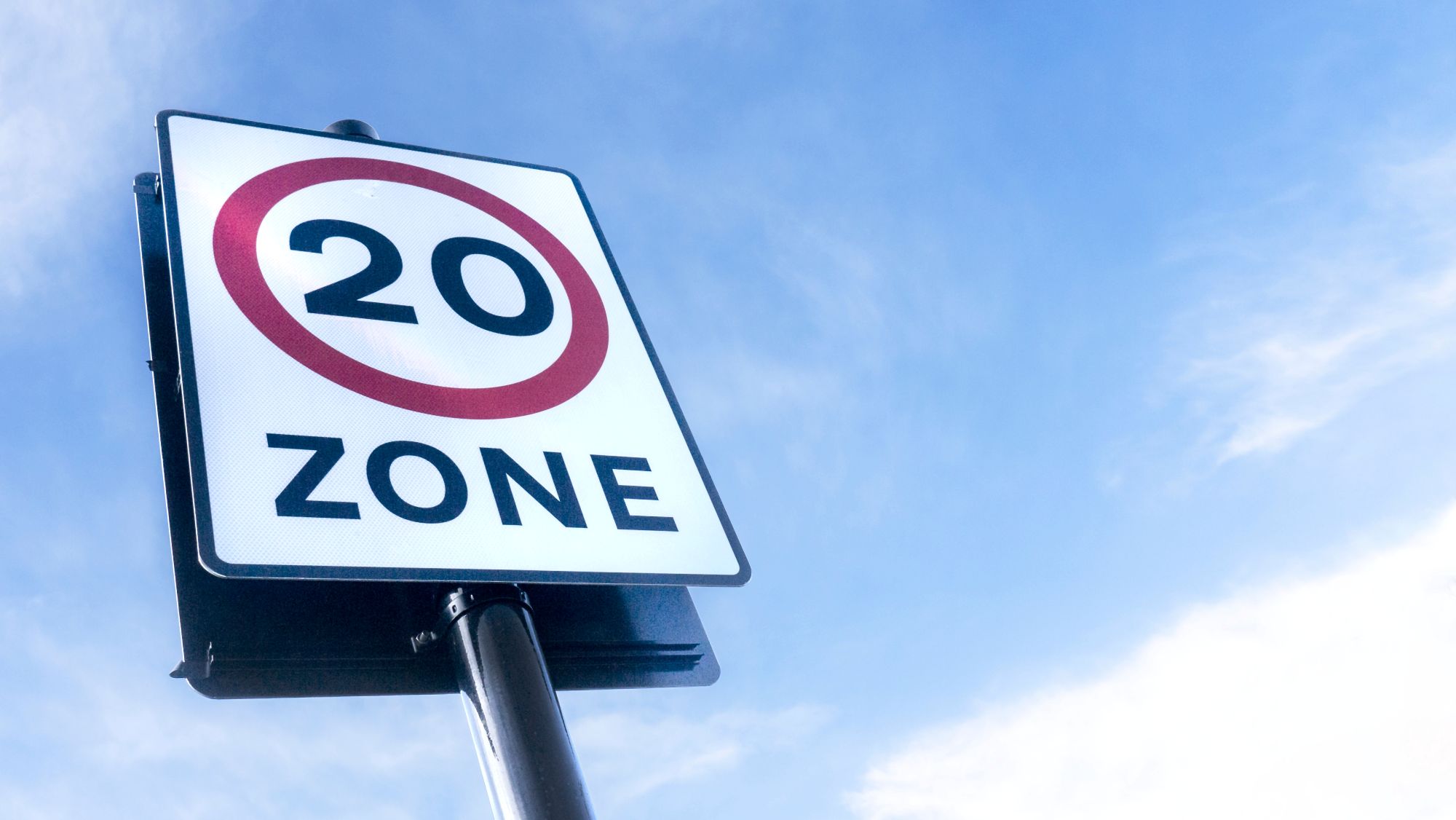
Susie Jones
Hvad er konsekvenserne af hastighedsgrænser på 20 km/t for flåder?
Oprettet: 16.04.2025
•
Opdateret: 16.04.2025
I 2023 var 188 lastbiler involveret i kollisioner, der resulterede i dødsfald, et fald fra 2022, men ikke desto mindre en bekymrende statistik. Disse ulykker kan skyldes flere faktorer, f.eks. træthed hos chaufføren, dårlig vedligeholdelse af køretøjet, vejrforhold eller andre trafikanters handlinger. Data fra trafiksikkerhedsorganisationen Brake viser dog, at [58 %] (https://www.brake.org.uk/get-involved/take-action/mybrake/knowledge-centre/uk-road-safety) af de trafikrelaterede dødsfald havde hastighed som en trafiksikkerhedsfaktor. I denne blog undersøger vi, hvordan indførelsen af hastighedsgrænser på 20 km/t kan påvirke flådedriften og sænke antallet af dødsfald.
Hvor sker ulykker med lastbiler?
Ifølge [EROS] (https://www.insurancerevolution.co.uk/blog/hgv-driving-safety-statistics/) skete kun 10 % af lastbilkollisionerne på en motorvej - de øvrige 90 % skete med større sandsynlighed på en by- eller landevej. Landeveje byder lastbilchauffører på snævre områder, skarpe sving og interaktioner med bløde trafikanter som cyklister og fodgængere, hvilket øger sandsynligheden for ulykker. Byområder udgør en større risiko for lastbilchauffører på grund af højere trafiktæthed, hyppige stop, fodgængeraktivitet og komplekse vejanlæg - kombineret med uforudsigeligheden ved byveje gør det dem til en større fare for lastbilchauffører.
Virkningen af 20 mph zoner.
Tal offentliggjort af [den walisiske regering] (https://motortransport.co.uk/industry-news/fleetcheck-urges-operators-to-back-calls-for-wider-use-of-20mph-speed-limits/25490.article) har vist 100 færre tilskadekomne på byveje i 2024 sammenlignet med samme periode i 2023, før hastighedsgrænsen på 20 km/t blev håndhævet i byområder.
Ordningen støttes af organisationer som Brake og Cycling UK, og nu opfordrer flådestyringsspecialisterne [FleetCheck] (https://motortransport.co.uk/industry-news/fleetcheck-urges-operators-to-back-calls-for-wider-use-of-20mph-speed-limits/25490.article) transportvirksomhederne til at bakke op om ordningen. De hævder, at skiftet fra 30 km/t til 20 km/t vil have minimal indflydelse på flådens effektivitet og styrker kraftigt ideen om, at det vil redde liv hvert år.

Hvad synes vognmænd og chauffører om hastighedsgrænsen på 20 km/t?
Ifølge FleetCheck havde vognmændene blandede følelser over for initiativet. Nogle så ændringerne som en hindring for effektiviteten - og hævdede, at lavere hastighedsgrænser kan tvinge nogle vognparker til at reducere antallet af leverancer, de kan foretage i en given periode.
Chaufførerne på SNAP's sociale medier havde stærke følelser over for forslaget. En chauffør kommenterede:
"Hvem vil bakke op om flere 20 km/t-zoner? Hele kørselsstandarden er problemet. Lige siden vi kom ud af lockdown, har kørselsstandarden været djævelsk, og det gælder både biler, varevogne og lastbiler."
Stemningen var den samme på de sociale medier, hvor mange ikke støttede ændringen.
Fordelene ved flere zoner med 20 km/t.
Nedsatte hastighedszoner giver flere fordele for lastbilchauffører.
Lavere hastigheder forbedrer reaktionstiden og reducerer bremselængden, hvilket gør det lettere at undgå kollisioner - især i byområder.
Lastbiler er mere tilbøjelige til at have mindre slid på køretøjet med reducerede hastighedsgrænser.
De forhindringer, flådevirksomhederne kan møde.
Som nævnt er nogle flådevirksomheder bekymrede for, at lavere hastighedsgrænser kan reducere antallet af leverancer, de kan foretage i en given periode. Flåderne kan også stå over for følgende udfordringer:
Længere rejsetider:** påvirker tidsfølsomme leverancer og påvirker planlægningen og kundernes forventninger.
Ruteplanlægning:** Virksomheder kan blive nødt til at justere ruterne for at tage højde for lavere hastigheder.
Overholdelse:** Det bliver afgørende at investere i yderligere chaufføruddannelse for at sikre, at de nye hastighedsgrænser overholdes.
Selv om disse problemer kan give ekstra udfordringer for flådevirksomheder, kan mange af dem håndteres proaktivt. Mange vil hævde, at de langsigtede sikkerhedsfordele opvejer forhindringerne.

Tallene taler for sig selv.
I en revideret kampagne med titlen [Hazardous Highways] (https://snapacc.com/hazardous-highways/) identificerede SNAP de farligste steder i Storbritannien. Vi dykker dybere ned for at finde ud af, hvilke veje der kunne have gavn af en lavere hastighedsgrænse.
SNAP opdagede, at det sydøstlige England havde de farligste veje. Kent har de farligste veje i Storbritannien og foreslår et mål om nul trafikdræbte på Kent Highway Network inden 2050. Hvilke veje er de mest bekymrende?
A254:** En kort vej på kun fire kilometer, men den blev udnævnt til Storbritanniens mest risikable rute i 2018. Rapporten udpegede en strækning af A254 mellem krydset med A28 ved Margate og krydset med A255 nær Ramsgate. Hastighedsgrænsen på denne strækning varierer mellem 30 og 40 km/t - bebyggede områder og en tung trafikstrøm fra havnen i Dover gør denne vej særligt farlig for cyklister, fodgængere og andre trafikanter. Kunne denne vejstrækning have gavn af lavere hastighedsgrænser?
A252:** A252 er berygtet for sine høje ulykkesrater og strækker sig over 8,7 km. I 2020 begyndte man at arbejde på at reducere antallet og alvoren af ulykker, og blandt ændringerne var et fald fra 60mph til 50mph på denne strækning, undtagen hvor lavere grænser er gældende. Men er det nok til at ryste vejens ry som en af Storbritanniens værste af sig?
Surrey og Essex lå også øverst på listen og havde tilsammen [30.378] (https://www.number1plates.com/blog/britains-worst-areas-for-road-accidents/#:~:text=With%2020%2C473%20recorded%20accidents%20from,as%20some%20of%20the%20worst.) ulykker i løbet af de sidste fem år. De høje ulykkestal i Surrey kan tilskrives blandingen af tætbefolkede byer og landeveje. Nærheden til London og de store motorveje har resulteret i flere kollisioner.
M25: M25 er også kendt som London Orbital Motorway og er en af Storbritanniens travleste veje og samtidig den næstlængste ringvej i Europa. Mellem 2007 og 2016 blev der rapporteret om 7.673 ulykker og 80 dødsfald. Som en afgørende motorvej ville hastighedsjusteringer på helt ned til 20 km/t være latterlige. Men ville M25 have gavn af begrænsede hastighedszoner?
A3: A3, der er 67 km lang, kan være en udfordrende vej at køre på på grund af den store trafikmængde, hastighedsbegrænsninger og strækninger med dårlige vejforhold.
Ofte stillede spørgsmål
Hvad er den maksimale hastighedsgrænse for lastbiler?
Lastbilchauffører skal overholde strenge hastighedsregler. Disse begrænsninger er indført for at tage højde for lastbilens størrelse, vægt og bremsekapacitet.
Single carriageways: En lastbil på over 7,5 ton må højst køre 50 km/t.
Dobbeltsporede veje: 60 km/t er den maksimale hastighedsgrænse for en lastbil på over 7,5 ton.
Motorveje: Lastbilchauffører må ikke køre mere end 100 km/t på motorvej.
Regler for hastighedsbegrænsere i Storbritannien I Storbritannien skal der installeres hastighedsbegrænsende anordninger i alle lastbiler for at begrænse den maksimale hastighed, køretøjet kan køre.
Lovkrav i Storbritannien: Alle lastbiler over 3,5 ton skal have en hastighedsbegrænser indstillet til 56 mph.
Sådan virker de:** Hastighedsbegrænsere begrænser brændstoftilførslen til motoren, når køretøjet når en forudindstillet hastighed - og sikrer, at føreren ikke kan overskride grænsen.
Har en privat lastbil brug for en fartbegrænser?
En privat lastbil behøver ikke en hastighedsbegrænser, medmindre den bruges til kommercielle formål. Du skal erklære, om dit køretøj er fritaget for at have en hastighedsbegrænser, når du tager det til syn, ved at udfylde en [erklæring om hastighedsbegrænser] (https://www.gov.uk/government/publications/hgv-speed-limiter-exemption-declaration-form).



